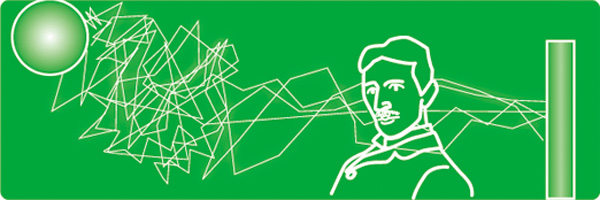- トップページ
- Fantastic Voyagers
- Who was Nikola Tesla?

Who was Nikola Tesla?
A scientist who thrilled the public.
In the United States, just before the dawn of the 20th century, a brilliant inventor captivated his audiences with spectacular shows of experimental science.
The leading edge of science today has reached a level that is rather difficult for the layperson to understand. Often, somebody’s work is reported as being of “Nobel prize class quality,” but even after reading the explanatory article, most of us are simply baffled, and instead just think “What’s so special about that?”
Particularly for research results in the field of basic science, it usually takes a very long time before they lead to any concrete, practically useful product. People in general don’t fully appreciate that all the electronic gadgets we couldn’t live without today – computers, the Internet, mobile phones, digital cameras, etc. – also required many years of hard work by a large number of devoted researchers to develop step by step. Perhaps the current so-called “science phobia” too is due to the fact that science itself has become difficult to understand.
However, way back over a century ago, there was a genius inventor who spellbound large audiences by presenting his own cutting-edge science as entertainment. His name was Nikola Tesla (1856-1943), and he was the greatest rival of the king of inventors, Thomas Alva Edison. Among Tesla’s invention was the alternating current system of electricity that is used everywhere in the world today. Tesla’s lectures, where he would demonstrate his latest results and inventions, were hugely popular at the time.
Immaculately dressed in a tailcoat and a white tie, he displayed his brilliant showmanship. For example, he would stand on the stage with a tube-like contraption in his hand, a prototype of what we today call a fluorescent light. “This is an ordinary glass tube, that I emptied of some air. When I hold it in my hand like this and touch a wire through which an alternating current is passing at high voltage, the glass tube in my hand starts shining brightly. Even if I put it down somewhere or move around in the room, it keeps shining with the same unfading, soft and gentle light as long as my hand stays in touch with it.” Today, the contents of his show may seem unremarkable, but at the time, artificial light was still rare and his eye-opening act struck people as “magic.” The clever young prodigy Tesla became an overnight sensation. One of his friends was the writer Mark Twain, who frequently witnessed performances by the “electric magician” in his lab.
The time when Tesla was in full swing at the end of the 19th and beginning of the 20th century was also a time when the American industrial culture was blooming and society as a whole was rushing towards the riches of the new century. Science and technology were synonymous with a sparkling future. The inventions that Tesla and Edison kept producing one after the other never ceased to thrill the masses as symbols of a “sense of wonder” (even if the underlying principles were not fully understood).
Now in the 21st century, we can perhaps no longer unreservedly praise science, but that is no reason to avoid science either. Mankind is facing a number of serious problems, and science that aims for the future can give us the power to solve them.
